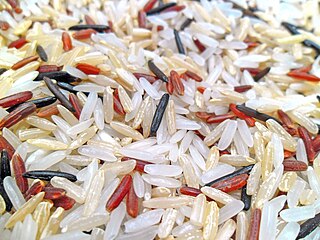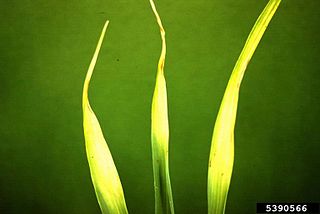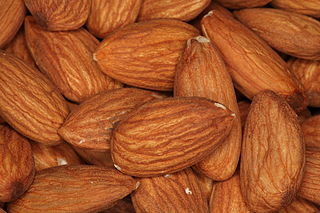Related Research Articles

Rice is the seed of the grass species Oryza sativa or less commonly Oryza glaberrima. The name wild rice is usually used for species of the genera Zizania and Porteresia, both wild and domesticated, although the term may also be used for primitive or uncultivated varieties of Oryza.

Narcissus is a genus of predominantly spring flowering perennial plants of the amaryllis family, Amaryllidaceae. Various common names including daffodil, narcissus, and jonquil are used to describe all or some members of the genus. Narcissus has conspicuous flowers with six petal-like tepals surmounted by a cup- or trumpet-shaped corona. The flowers are generally white and yellow, with either uniform or contrasting coloured tepals and corona.

A leaf spot is a limited, discoloured, diseased area of a leaf that is caused by fungal, bacterial or viral plant diseases, or by injuries from nematodes, insects, environmental factors, toxicity or herbicides. These discoloured spots or lesions often have a centre of necrosis. Symptoms can overlap across causal agents, however differing signs and symptoms of certain pathogens can lead to the diagnosis of the type of leaf spot disease. Prolonged wet and humid conditions promote leaf spot disease and most pathogens are spread by wind, splashing rain or irrigation that carry the disease to other leaves.

Richard William Timm was a Catholic Priest, educator, zoologist, and development worker. He was the Superior of the Congregation of Holy Cross in Dhaka and a member of the Sacred Heart of Jesus Province. He was also one of the founders of Notre Dame College in Dhaka, Bangladesh. He was the 6th principal of Notre Dame College.
Aphelenchoides arachidis is a plant pathogenic nematode.

Aphelenchoides besseyi is a plant pathogenic nematode. It is sometimes referred to as rice white tip, spring dwarf, strawberry bud, flying strawberry nematode or strawberry crimp disease nematode. This foliar nematode is found in Africa, North, Central, and South America, Asia, Eastern Europe, and Pacific islands.
Aphelenchoides coffeae is a plant pathogenic nematode.

Foliar nematodes are plant parasitic roundworms in the genus Aphelenchoides. The three most economically important species are Aphelenchoides fragariae, A. ritzemabosi, and A. besseyi. Foliar nematodes are becoming a widespread and serious problem for the ornamental and nursery industries. A. fragariae causes damage on hundreds of different plants including chrysanthemum, begonia, gloxinia, African violet, cyclamen, and a wide variety of bedding plants and ferns, causing brown to black, vein-delimited lesions on leaf tissue, defoliation, and possible stunting of plants.
Fern nematode may refer to:

Bursaphelenchus xylophilus, commonly known as pine wood nematode or pine wilt nematode (PWN), is a species of nematode that infects trees in the Pinus genus of coniferous trees and causes the disease pine wilt. While native to North America, it spread in the early 20th century to Japan and in the latter half of the century to other areas of Asia, including China, Taiwan and Korea, as well as to Europe, including Portugal and Spain.

The nematodes or roundworms constitute the phylum Nematoda, with plant-parasitic nematodes also known as eelworms. They are a diverse animal phylum inhabiting a broad range of environments. Less formally, they are categorized as Helminths, but are taxanomically classified along with arthropods, tardigrades and other moulting animals in the clade Ecdysozoa, and unlike flatworms, have tubular digestive systems with openings at both ends. Like tardigrades, they have a reduced number of Hox genes, but their sister phylum Nematomorpha has kept the ancestral protostome Hox genotype, which shows that the reduction has occurred within the nematode phylum.
Aphelenchoides is a genus of mycetophagous nematodes. Some species are plant pathogenic foliar nematodes.
Antarctica is one of the most physically and chemically extreme terrestrial environments to be inhabited by lifeforms. The largest plants are mosses, and the largest animals that do not leave the continent are a few species of insects.
Aphelenchoididea is a nematode superfamily in the order Rhabditida. Its members can be found inside bodies of species from the families Lepidoptera and Blattodea.

Aphelenchoididae is a nematode family in the order Aphelenchida.
Aphelenchoides subtenuis is a plant pathogenic nematode. It is an important cause of disease in daffodils (Narcissus).

Agriculture is a significant sector in California's economy, producing nearly $50 billion in revenue in 2018. There are more than 400 commodity crops grown across California, including a significant portion of all fruits, vegetables, and nuts for the United States. In 2017, there were 77,100 unique farms and ranches in the state, operating across 25.3 million acres of land. The average farm size was 328 acres (133 ha), significantly less than the average farm size in the U.S. of 444 acres (180 ha).
Aphelenchoides bicaudatus is a nematode parasite of Elaeidobius kamerunicus, Vigna marina, and Agaricus bisporus.

Cladonia glauca or the glaucous cup lichen is a species of fruticose, cup lichen in the family Cladoniaceae. Found in Europe, it was formally described as a new species in 1828 by German botanist Heinrich Gustav Flörke. The nematodes Aphelenchoides lichenicola and Ottolenchus cabi feed on this lichen.